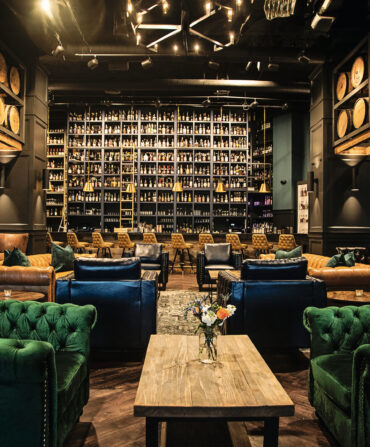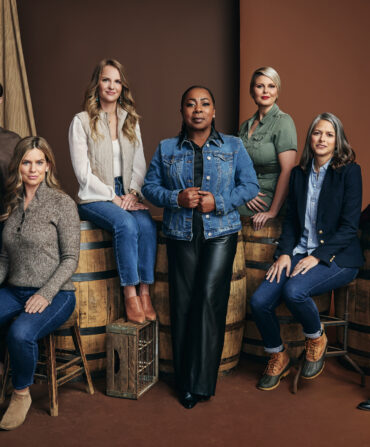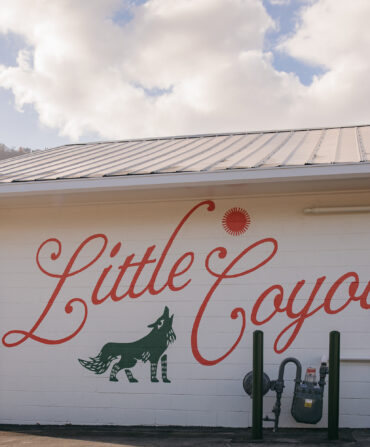Food & Drink
Keepers of the Flame
Why the golden age of the pit master may still be ahead of us
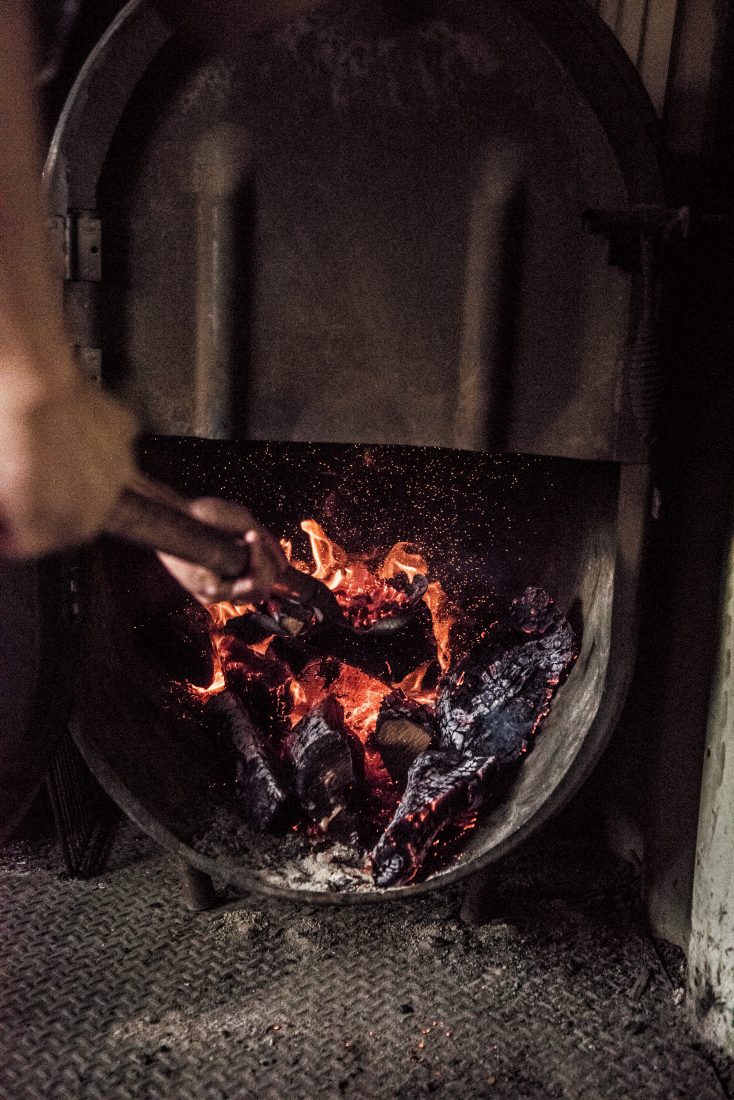
Photo: Randy Harris
A filmmaker at work on a barbecue documentary recently interviewed me. He floated the usual questions: “Pork or beef—which is the gospel protein?” And “Ketchup or vinegar sauce—which would you rather pour down the sink than drizzle on your sandwich?” I offered my usual responses: pork and ketchup. But when he asked me about the future, I threw him off the scent and declared myself an optimist.
Barbecue is a conservative craft. Generational decline is assumed. Stasis has long been the goal. But I don’t buy that script. I don’t believe that the barbecue of my youth outshone anything my son will savor in his lifetime. I know in my bones that my best slaw-and-shoulder sandwiches and your best pit-charred ribs lie ahead.
Once beleaguered, once besieged by the advance of fast foods and a decline in appreciation for artisanal goods, barbecue is now in renaissance. Today, the craft is vibrant, dynamic, even progressive. So are the men and women who stoke the fires, stuff the sausages, flip the hogs, and pitchfork the briskets.
Barbecue restaurant owners once challenged their children to take alternate career paths. The work is grimy, they said. It’s thankless, they warned. Barbecue restaurants are joints where devotees go slumming, they chided. But a change has come. Pit masters now climb the same ladder from the basement that chefs ascended a generation back.
As America reevaluates its culinary identities, as Southerners recognize barbecue to be our premier folk food, we reframe those joints as sites of pilgrimage where seekers find solace as well as honest eats. Today, we celebrate the people who work those shrines.
I’m not just praising old codgers. Young pit masters are also stepping into the smoke. In Lexington, North Carolina, the grandchildren of Wayne “Honey” Monk are now hitching up their dungarees. Down in Savannah, Bryan Furman, a first-generation pit convert, is proving that he can cook heritage hogs and deliver eight-buck sandwiches.
Respect for the vocation is building. This spring, the James Beard Foundation, our nation’s barometer of culinary excellence, named Aaron Franklin of Franklin Barbecue in Austin, Texas, a finalist for Best Chef: Southwest. He is the first pit master to advance that far. He won’t be the last. (Full disclosure: I serve on one of the committees that administer the awards.)
By the time you read this, we will know if Franklin has won. What I know right now is that the rise of the pit master is not a trend. It’s not a fad. It’s a moment of long-overdue recognition. (Update: He won)
When I visited Tyson Ho at Arrogant Swine, his roadhouse on the industrial fringe of Bushwick in Brooklyn, he talked me through the reasons he gave up a career in finance for a life in the pits. In his telling, I recognized one of the more compelling reasons that a wide range of Southerners, born and adopted, have recently embraced the persona.
“This is the oldest style of American cooking,” Ho said, after I ate a round of hickoried chicken wings and drank a tumbler of whiskey, as we gazed into the maw of his burn barrel. “Before America was even a country, some dude was already digging a hole and throwing on logs and a pig. Whether that person came over on the Mayflower or that person came over in chains, I share that history with them every time I light my fire.”—John T. Edge
Fire Brigade
From Texas to New York, meet a new generation of pit masters giving an old art a bright future
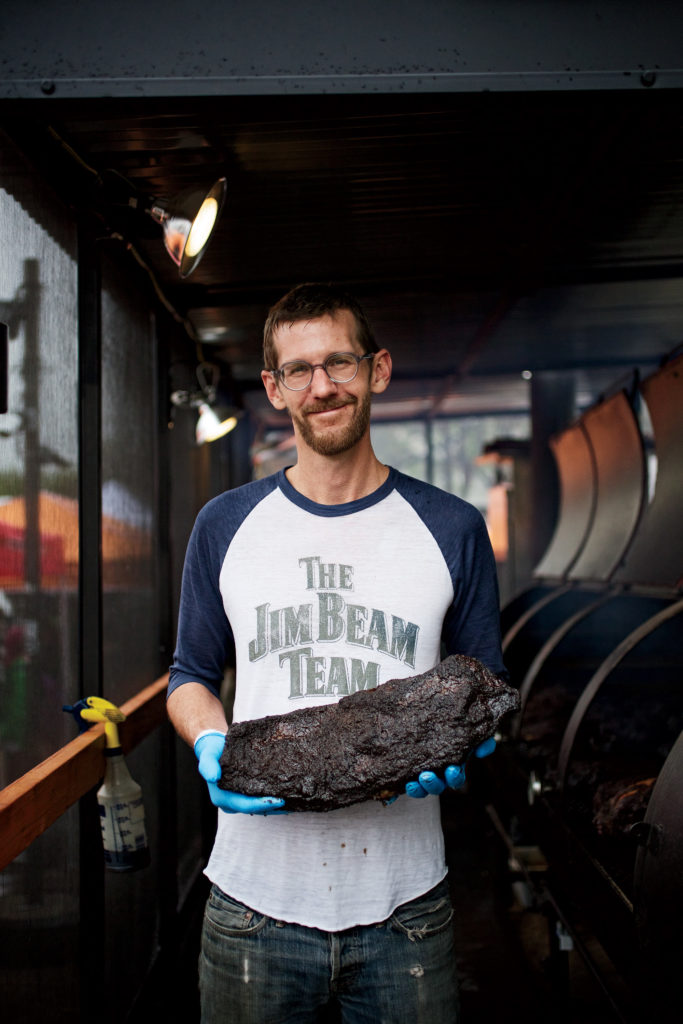
The Brisket Evangelist: John Lewis
Restaurant: La Barbecue
Est.: 2012
Location: Austin, TX
You can track the evolution of John Lewis through his cooking equipment. First came a run-of-the-mill offset smoker from Home Depot. Then an electric smoker. Not good enough. He built his own out of steel trash cans in his backyard, then one from a refrigerator. Still not there. So he taught himself to weld and moved on to fifty-five-gallon steel drums. That was around the time he began lending a hand to pit master Aaron Franklin, who’d just opened the Austin barbecue trailer that would become a brick-and-mortar joint with five-hour lines. For the past several years Lewis has run the pits at La Barbecue, where he has welded 1,000-gallon cookers from old propane tanks, engineered to his exacting specifications.
A former pastry chef, Lewis approaches barbecue with the same attention to detail. He uses only well-marbled prime brisket, and he seasons the meat with more than just the old frontier coupling of salt and black pepper, steeping it also in the spice and pucker of mustard and pickle juice, among other additions. That brisket, along with his beef ribs and scratch-made sausages, has earned a loyal following. Last year, the Austin American-Statesman named his place the best in town. Now Lewis is doing something no Texas pit master of his stature has done: taking his barbecue east, to the soon-to-open Lewis Barbecue in Charleston, South Carolina. “I don’t know why no one has done it before,” Lewis says. “The meats are going to stay the same, but the sides will probably be a little different. I’m sure I’ll be doing something with greens.”
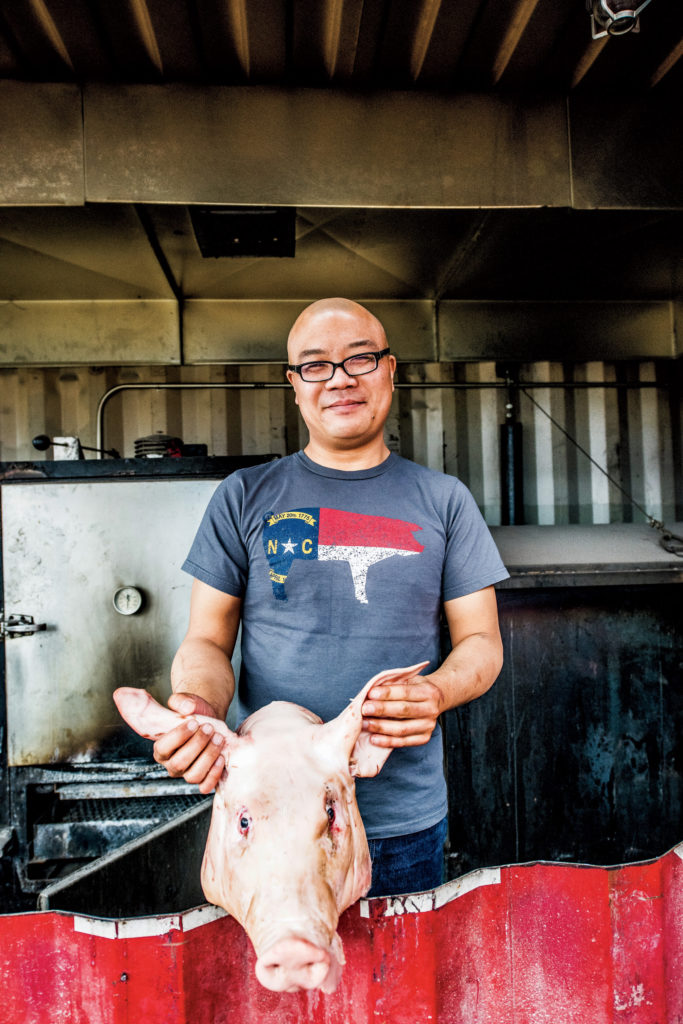
The City Slicker: Tyson Ho
Restaurant: Arrogant Swine
Est.: 2014
Location: Brooklyn, NY
Last winter, the woodpile behind Arrogant Swine froze solid. For weeks. “We burn our wood down to coals, which is a pain in North Carolina,” Tyson Ho says. “It’s a royal pain in New York City.” Sure, he could have switched to store-bought briquettes. Instead, he and his lone pit assistant pulled on their coats and stoked the burn barrel until they coaxed the wood to crumble into the embers that slow-cook the restaurant’s pigs. That stubborn adherence to tradition is at the heart of Ho’s restaurant, a labor of love for a former financial research manager who discovered whole-hog barbecue on a trip to Ayden, North Carolina, and has been educating the urban uninformed ever since.
Before the Queens native quit his white-collar job to become a full-time pit master, he spent months learning to cook whole hogs in the traditional eastern North Carolina style. He studied oral histories in university archives and traveled back to the state, nosing into back rooms from Raleigh to Farmville and spending time under the tutelage of renowned pit master Ed Mitchell, among others.
His new restaurant isn’t only a temple to barbecue. Reviewers are as likely to mention the craft beer selection or the waffle-ironed macaroni and cheese as the meat. But it is the only place in the city where you will regularly see butterflied hogs rendering in the orange glow of local oak and honey locust coals.
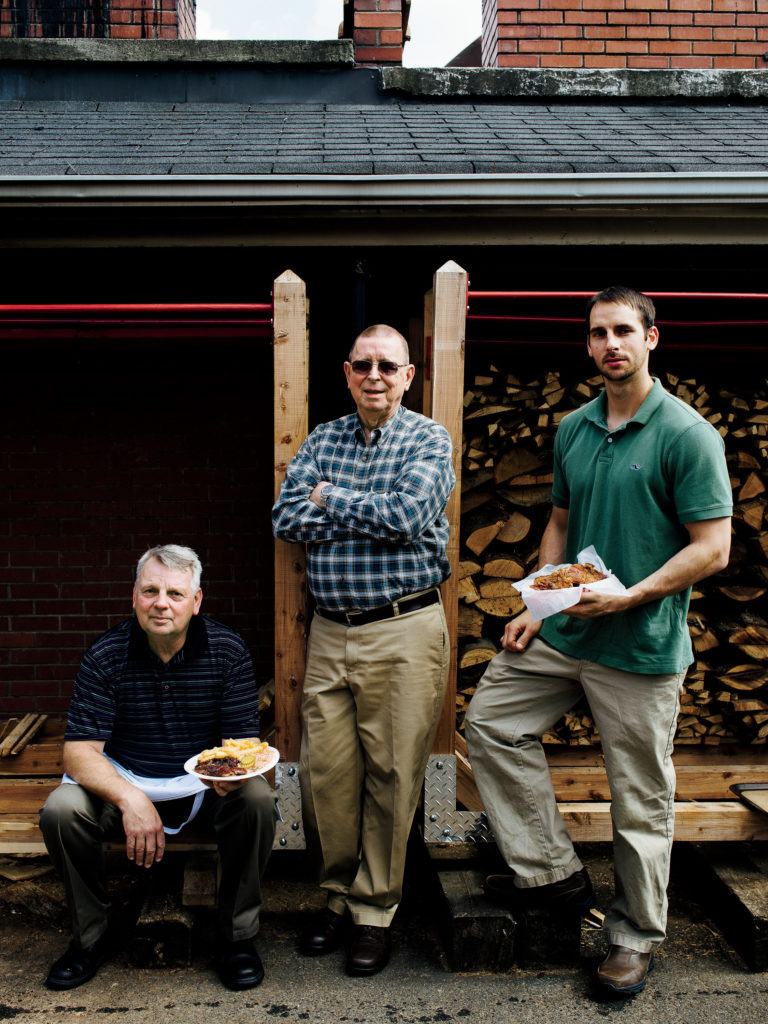
The Barbecue Dynasty: The Monk Family
Restaurant: Lexington Barbecue
Est.: 1962
Location: Lexington, NC
A century ago, Jess Swicegood sold barbecue under a tent in Lexington, North Carolina. He taught a high school student named Warner Stamey how to make what is now known as Lexington-style barbecue: chopped pork shoulder dressed with a ketchup-tinged vinegar sauce. Stamey passed his knowledge on to a young man named Wayne Monk (pictured below center), who founded the aptly named Lexington Barbecue, which has set a regional standard for half a century. That rich legacy won’t die out anytime soon. Today, three generations of Monks keep the pits smoking six days a week.
“It’s not a job,” says Rick Monk (below left), Wayne’s son. “It’s a way of life.” Rick took his first job at the restaurant at thirteen. Depending on the day, he might be pit master, bookkeeper, or janitor. The hours are long, but the rewards are worth it. “I don’t dread and cuss my job like some people do,” he says. “I enjoy being here.” Rick’s son Nathan (below right) first stepped into the kitchen some fifteen years ago. He’s thirty-one now, and he still works alongside his father, grandparents, brothers, uncle, and cousin. He has two daughters, one three and one five months, a little young to shovel coals. But he wouldn’t be surprised if they join the family business, too. “You learn how to talk to people,” he says. “You get to know this community.” And with each generation, the Monks add new chapters to a story many platters of pork and red slaw in the making.

The Baron of Barbacoa: Armando Vera
Restaurant: Vera’s Backyard Bar-B-Que
Est.: 1955
Location: Brownsville, TX
Armando Vera wakes up at 3:00 a.m. each Saturday and Sunday. His customers begin to arrive an hour and a half later to pick up their orders: cuts of beef tongue, cheek, and eye, served on corn tortillas and dressed with fresh salsa. The cooks who created barbacoa were borderland cowboys, who buried cast-aside cows’ heads with mesquite coals overnight. In Brownsville, Texas, as in other border towns, barbacoa is still a traditional breakfast—for oil rig workers, and for regulars who leave home in the dark just to make sure they don’t miss out on the best cuts. They tend to be particularly fond of the ojos. “I had a customer last week, she wanted me to sell her fifteen eyes,” Vera says. “I told her no. I like to be fair to all of my customers.”
Although plenty of Texas joints still serve oven-roasted and steamed heads, Vera might be the last pit master in the country who makes barbacoa the old-fashioned way, in an underground pit lined with wood coals. It’s the same way his father did it when he founded the restaurant sixty years ago, and to Vera’s loyal customers, barbacoa without a kiss of mesquite smoke might as well come out of a microwave. “Some of the others who bake it and steam it sell more than me,” he says. “For me, though, the pit gives it a different taste. It’s what you’re brought up eating.” Not that he hasn’t won some new converts, too. “The mesquite wood, the pit—some people come in and taste it and just like it.”

Photo: Andrew Thomas Lee
To make has, he simmers meat from the head with pork shoulder and seasonings. He serves it over rice, as cooks do in his hometown, Camden, South Carolina.
The Roadside Entrepreneur: Bryan Furman
Restaurant: B’s Cracklin BBQ
Est.: 2014
Location: Savannah, GA
Bryan Furman was a welder who had never worked in a professional kitchen, but he loved to cook barbecue. He catered parties. He made ribs for coworkers. And though he had plenty to do at his day job, he thought he might be destined for something else.
First, though, the would-be pit master had to answer a persistent question from his father: “What is going to make your barbecue joint different?” He had two ideas: He would seek out flavorful heritage hogs—the likes of Mulefoot, Ossabaw, and Chester White—and he would make all of his sides from scratch, with as many local ingredients as possible. Less than a year after he opened his humble takeout joint, the weekend crowds gathered outside testify to the results of those labor-intensive choices.
The place is still mostly a one-man show, thanks in part to Furman’s improvisational style. He might decide to put smoked chicken feet on the menu, or add extra peach puree to his coleslaw, and he doesn’t trust hired help to get the flavors right. (He leaves that to his wife, Nikki, who has a knack for tasting.) Furman has employed a neighborhood kid to help with the dishes, and a friend helps stoke the fire out back. But the pit master still handles everything from buying collards to simmering the traditional hog’s-head hash. Which is why he only opens for business Thursday through Sunday. “If I did any more than that,” he says, “it would kill me.”



